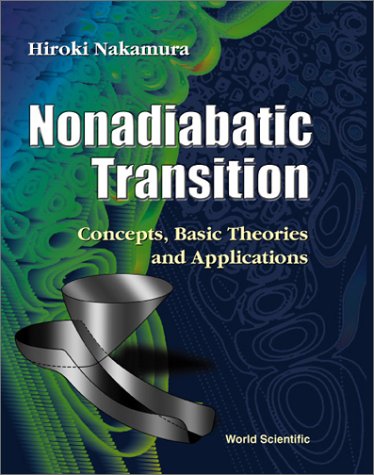

Most ebook files are in PDF format, so you can easily read them using various software such as Foxit Reader or directly on the Google Chrome browser.
Some ebook files are released by publishers in other formats such as .awz, .mobi, .epub, .fb2, etc. You may need to install specific software to read these formats on mobile/PC, such as Calibre.
Please read the tutorial at this link. https://ebooknice.com/page/post?id=faq
We offer FREE conversion to the popular formats you request; however, this may take some time. Therefore, right after payment, please email us, and we will try to provide the service as quickly as possible.
For some exceptional file formats or broken links (if any), please refrain from opening any disputes. Instead, email us first, and we will try to assist within a maximum of 6 hours.
EbookNice Team

Status:
Available4.6
11 reviews(Ebook) Nonadiabatic transition concepts basic theories and applications 1st Edition by Hiroki Nakamura - Ebook PDF Instant Download/Delivery: 9789810247195 ,9810247192
Full download (Ebook) Nonadiabatic transition concepts basic theories and applications 1st Edition after payment

Product details:
ISBN 10: 9810247192
ISBN 13: 9789810247195
Author: Hiroki Nakamura
(Ebook) Nonadiabatic transition concepts basic theories and applications 1st Edition Table of contents:
Chapter 1 Introduction: What is "Nonadiabatic Transition"?
Chapter 2 Multi-Disciplinarity
2.1. Physics
2.2. Chemistry
2.3. Biology
2.4. Economics
Chapter 3 Historical Survey of Theoretical Studies
3.1. Landau-Zener-Stueckelberg Theory
3.2. Rosen-Zener-Demkov Theory
3.3. Nikitin's Exponential Model
3.4. Nonadiabatic Transition Due to Coriolis Coupling and Dynamical State Representation
Chapter 4 Background Mathematics
4.1. Wentzel-Kramers-Brillouin Semiclassical Theory
4.2. Stokes Phenomenon
Chapter 5 Basic Two-State Theory for Time-Independent Processes
5.1. Exact Solutions of the Linear Curve Crossing Problems
5.1.1. Landau-Zener type
5.1.2. Nonadiabatic tunneling type
5.2. Complete Semiclassical Solutions of General Curve Crossing Problems
5.2.1. Landau-Zener (LZ) type
5.2.1.1. E > Ex (b2 > 0)
5.2.1.2. E < Ex (b2 < 0)
5.2.1.3. Numerical examples
5.2.2. Nonadiabatic Tunneling (NT) Type
5.2.2.1. E < Et (b2 < -1)
5.2.2.2. Et 5.2.2.3. E > Eb (b2 > 1) 5.2.2.4. Complete reflection 5.2.2.5. Numerical examples 5.3. Non-Curve-Crossing Case 5.3.1. Rosen-Zener-Demkov model 5.3.2. Diabatically avoided crossing model 5.4. Exponential Potential Model 5.5. Mathematical Implications 5.5.1. Case (i) 5.5.2. Case (ii) 5.5.3. Case (iii) Chapter 6 Basic Two-State Theory for Time-Dependent Processes 6.1. Exact Solution of Quadratic Potential Problem 6.2. Semiclassical Solution in General Case 6.2.1. Two-crossing case: B > 0 (see Fig. 6.1(a)) 6.2.2. Diabatically avoided crossing case: B < 0 (see Fig. 6.1(b)) 6.3. Other Exactly Solvable Models Chapter 7 Two-State Problems 7.1. Diagrammatic Technique 7.2. Inelastic Scattering 7.3. Elastic Scattering with Resonances and Predissociation 7.4. Perturbed Bound States 7.5. Time-Dependent Periodic Crossing Problems Chapter 8 Effects of Dissipation and Fluctuation Chapter 9 Multi-Channel Problems 9.1. Exactly Solvable Models 9.1.1. Time-independent case 9.1.2. Time-dependent case 9.2. Semiclassical Theory of Time-Independent Multi-Channel Problems 9.2.1. General framework 9.2.1.1. Case of no closed channel (m = 0) 9.2.1.2. Case of m # 0 at energies higher than the bottom of the highest adiabatic potential 9.2.1.3. Case of m # 0 at energies lower than the bottom of the highest adiabatic potential 9.2.2. Numerical example 9.3. Time-Dependent Problems Chapter 10 Multi-Dimensional Problems 10.1. Classification of Surface Crossing 10.1.1. Crossing seam 10.1.2. Conical intersection 10.1.3. Renner-Teller effect 10.2. Reduction to One-Dimensional Multi-Channel Problem 10.2.1. Linear Jahn-Teller problem 10.2.2. Collinear chemical reaction 10.2.3. Three-dimensional chemical reaction 10.3. Semiclassical Propagation Method Chapter 11 Complete Reflection and Bound States in the Continuum 11.1. One NT-Type Crossing Case 11.2. Diabatically Avoided Crossing (DAC) Case 11.3. Two NT-Type Crossings Case 11.3.1. At energies above the top of the barrier: (Eu, oo) 11.3.2. At energies between the barrier top and the higher crossing: (E+, EU) 11.3.3. At energies in between the two crossing regions: (E-, E+) 11.3.4. At energies below the crossing points: (- oo, E_ ) 11.3.5. Numerical examples Chapter 12 New Mechanism of Molecular Switching 12.1. Basic Idea 12.2. One-Dimensional Model 12.2.1. Transmission in a pure system 12.2.2. Transmission in a system with impurities 12.2.3. Molecular switching 12.3. Two-Dimensional Model 12.3.1. Two-dimensional constriction model 12.3.2. Wave functions matching and transmission coefficient 12.4. Numerical Examples Chapter 13 Control of Nonadiabatic Processes by an External Field 13.1. Control of Nonadiabatic Transitions by Periodically Sweeping External Field 13.2. Basic Theory 13.2.1. Usage of the Landau-Zener-Stueckelberg type transition 13.2.2. Usage of the Rosen-Zener-Demkov type transition 13.2.3. General case 13.3. Numerical Examples 13.3.1. Spin tunneling by a magnetic field 13.3.2. Vibrational and tunneling transitions by laser 13.3.2.1. Landau-Zener-Stueckelberg type transition 13.3.2.2. Rosen-Zener-Demkov type transition 13.3.2.3. General case 13.4. Laser Control of Photodissociation with Use of the Complete Reflection Phenomenon Chapter 14 Conclusions: Future Perspectives Appendix A Final Recommended Formulas for General Time-Independent Two-Channel Problem A.l. Landau-Zener Type A.l.l. E> Ex (crossing energy) (b2 > 0) A.1.2. E < Ex (b2 < 0) A.1.3. Total scattering matrix A.2. Nonadiabatic Tunneling Type (see Fig. A.2) A.2.1. E>Eb A.2.2. Eb>E>Et A.2.3. E < Et Appendix B Time-Dependent Version of the Zhu-Nakamura Theory Bibliography Index People also search for (Ebook) Nonadiabatic transition concepts basic theories and applications 1st Edition: 3 basic principles of aba Tags: Hiroki Nakamura, Nonadiabatic transition, applications, theories
concepts of transitions theory
nonadiabatic molecular dynamics
what are the concepts of transition theory
non stage theory examples